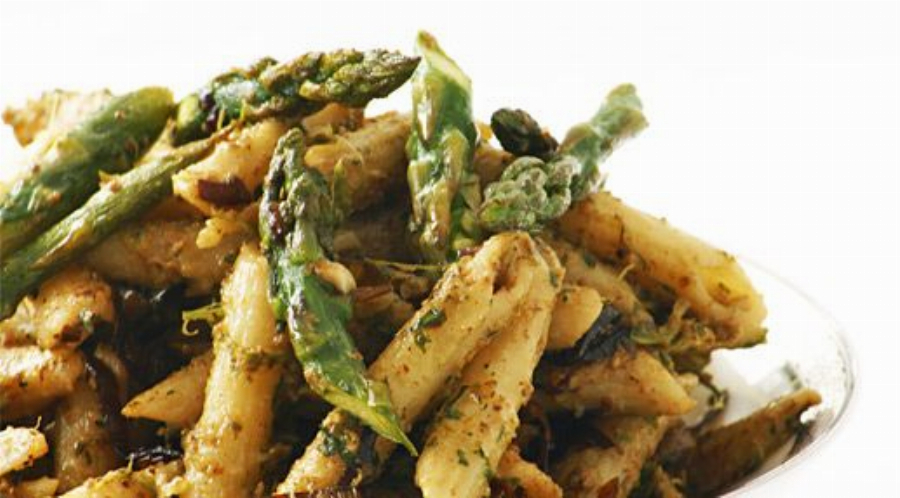I had some leftover curly parsley from my stuffed tomatoes, and some walnuts leftover from my kiwi tarts, and I needed to figure out what to do with them. Pesto seemed like the perfect way to utilize the ingredients I had on hand. The parsley provided the green color and “herby” flavor typically delivered by the more commonly used basil. I used the walnuts in place of pine nuts, and blended them with the parsley along with some olive oil. I added some walnut oil as well to accentuate the flavor of the whole walnuts and tossed the mixture with sautéed leeks and asparagus and mini penne pasta.
Finding ways to use not only your leftovers, but your leftover ingredients, will save you time and money. You just need to have a few flexible, go-to recipes in your culinary arsenal, and you’ll be prepared to face whatever your refrigerator and pantry throw at you. Pesto is definitely one of those recipes.
1. Info for Parsley-Walnut Pesto Penne Pasta with Asparagus
- Cook Time: unavailable
- Total Time: unavailable
- Servings: 10
- Calories: unavailable
2. Ingredients for Parsley-Walnut Pesto Penne Pasta with Asparagus
- 2 (16-ounce) packages mini penne (sometimes called mezze penne)
- 1/2 cup leek (white part only), thinly sliced
- 1-1/2 cups curly parsley, packed
- 1 cup whole walnuts
- 1/8 teaspoon black pepper, freshly ground
- 2 teaspoons garlic, minced
- 1/2 cup olive oil, as needed
- 2 tablespoons walnut oil
- 1-1/2 tablespoons lemon juice
- 1-1/2 teaspoons salt
- 1 teaspoon green peppercorns
- 2 tablespoons capers
- 1 bunch baby green asparagus
3. Directions:
- Preheat the oven to 325°F.
- For the walnuts: To release all the flavor and oil of the nuts, roast the walnuts in the oven for about 10 minutes at 325°F before using them. Chop the nuts. Grind the roasted walnuts in a food processor or spice grinder. Make sure you stop before it turns into walnut butter. Set aside.
- For the curly parsley: Wash the parsley (stems included, because that’s where the flavor is the most potent). Quickly blanch it for about 5-10 seconds in boiling salted water and transfer to an ice bath, to maintain a bright green color. Drain thoroughly of all water and pat dry on paper towels. Coarsely chop the parsley.
- For the parsley-walnut pesto: In a blender (or a mini-food prep if you have one), mix the parsley, ground walnuts, 3 tablespoons of olive oil, the walnut oil, garlic, 1/3 teaspoon of salt and 1/8 teaspoon of black pepper. Add about 2 tablespoons (or more) of water for a smooth flow. Set aside.
- For the mini penne pasta: Bring about 8 quarts of water to a boil. Add the pasta, bring back to a boil, then immediately lower the heat to a gentle boil. That way the pasta is cooked all the way through evenly. Cook the pasta for about 12 minutes total. Salt (with 2/3 teaspoon) the water half-way through the cooking process (it will bring out the natural flavor of the pasta and the pasta will be more tender) and keep stirring every now and then so the pasta doesn’t stick to the bottom. It may take longer than the cooking time that’s written on the box. When the pasta is cooked (cooked inside and out but still in shape and firm), transfer it to a large flat platter. Add the lemon juice. Season with the 1/3 teaspoon of salt.
- For the asparagus: Trim about 1/2 inch from the root. Cut the asparagus into 2-inch pieces. In a large pot, add the remaining olive oil. Add the leeks and cook them until golden. Add the asparagus and sauté for about 2-3 minutes. Season with salt and green peppercorns. Transfer to a platter. Set aside.
- Assembly time: In the same pot, add the cooked penne pasta. Add a little more oil if necessary. Add about 5-6 tablespoons of the parsley-walnut pesto. Toss well. Add the sautéed asparagus and capers.
- Serve immediately.
- Bon appétit!

